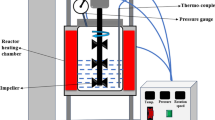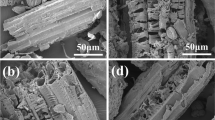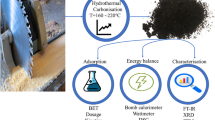Abstract
Recently, improving the adsorption capacity of pristine hydrochar by selecting an environmentally friendly, readily available, and low-cost modifier has become a research hotspot. In this research, the pristine hydrochar derived from sawdust (HTC) was treated using the H2O2, which was expected to get the modified hydrochar (HTC-H) with excellent properties beneficial for methylene blue (MB) removal. Compared to HTC, the HTC-H had higher surface area (increased by 11.20%) and larger CEC (increased by 11.80%); besides, the oxygen-containing functional groups of HTC-H was richer than that of HTC, evidenced by element analysis (higher O/C) and Fourier transform infrared spectroscopy analysis. Because of the improvement of these characteristics, the MB maximum adsorption capacity of HTC-H increased by 45.70%. Moreover, MB adsorption kinetics of HTC-H fit well with the pseudo-second-order-model. In addition, MB adsorption capacity increased at both high pH and ion strengths. All the results showed the H2O2-modified hydrochar has a good application prospect in environmental applications requiring MB removal.
Graphical abstract





Similar content being viewed by others
Data Availability
Applicable.
Code Availability
Not applicable.
References
Allègre, C., Moulin, P., Maisseu, M., & Charbit, F. (2006). Treatment and reuse of reactive dyeing effluents. Journal of Membrane Science, 269(1–2), 15–34.
Arellanoa, O., Flores, M., Guerra, J., Hidalgo, A., Rojas, D., Strubinger, A.J.C.E. (2016). Hydrothermal carbonization (HTC) of corncob and characterization of the obtained hydrochar. Chemical Engineering, 50.
Aygün, A., Yenisoy-Karakaş, S., & Duman, I. (2003). Production of granular activated carbon from fruit stones and nutshells and evaluation of their physical, chemical and adsorption properties. Microporous and Mesoporous Materials, 66(2–3), 189–195.
Banat, F., Al-Asheh, S., & Al-Makhadmeh, L. (2003). Evaluation of the use of raw and activated date pits as potential adsorbents for dye containing waters. Process Biochemistry, 39(2), 193–202.
Benavente, V., Calabuig, E., & Fullana, A. (2015). Upgrading of moist agro-industrial wastes by hydrothermal carbonization. Journal of Analytical and Applied Pyrolysis, 113, 89–98.
Chia, C. H., Gong, B., Joseph, S. D., Marjo, C. E., Munroe, P., & Rich, A. M. J. V. S. (2012). Imaging of mineral-enriched biochar by FTIR, Raman and SEM–EDX. Vibrational Spectroscopy, 62, 248–257.
Dai, Y., Zheng, H., Jiang, Z., & Xing, B.J.S.o.t.t.e. (2020). Combined effects of biochar properties and soil conditions on plant growth: A meta-analysis. Science of the Total Environment, 713, 136635.
Fadillah, G., Saleh, T. A., Wahyuningsih, S., NindaKarlinaPutri, E., & Febrianastuti, S. (2019). Electrochemical removal of methylene blue using alginate-modified graphene adsorbents. Chemical Engineering Journal, 378, 122140.
Fan, S., Wang, Y., Wang, Z., Tang, J., Tang, J., & Li, X. (2017). Removal of methylene blue from aqueous solution by sewage sludge-derived biochar: Adsorption kinetics, equilibrium, thermodynamics and mechanism. Journal of Environmental Chemical Engineering, 5(1), 601–611.
Fang, J., Gao, B., Chen, J., & Zimmerman, A. R. J. C. E. J. (2015). Hydrochars derived from plant biomass under various conditions: Characterization and potential applications and impacts. Chemical Engineering Journal, 267, 253–259.
Fang, J., Gao, B., Mosa, A., Zhan, L. J. C. S., Bioavailability. (2017). Chemical activation of hickory and peanut hull hydrochars for removal of lead and methylene blue from aqueous solutions. Chemical Speciation & Bioavailability, 29(1), 197–204.
Fang, J., Zhan, L., Ok, Y. S., & Gao, B. (2018). Minireview of potential applications of hydrochar derived from hydrothermal carbonization of biomass. Journal of Industrial and Engineering Chemistry, 57, 15–21.
Ferrentino, R., Ceccato, R., Marchetti, V., Andreottola, G., & Fiori, L. (2020). Sewage sludge hydrochar: An option for removal of methylene blue from wastewater. Applied Sciences, 10(10), 3445.
Ghasemi, J., & Asadpour, S. (2007). Thermodynamics’ study of the adsorption process of methylene blue on activated carbon at different ionic strengths. The Journal of Chemical Thermodynamics, 39(6), 967–971.
Hamid, N. A. A., & Zulkifli, N. Z. (2021). Papaya peels as source of hydro char via hydrothermal carbonization. IOP Conference Series: Earth and Environmental Science, 765(1), 012001.
Hammud, H. H., Karnati, R. K., Al Shafee, M., Fawaz, Y., & Holail, H. J. C. E. C. (2021). Activated hydrochar from palm leaves as efficient lead adsorbent. Chemical Engineering Communications, 208(2), 197–209.
Hessien, M. J. E. (2022). Microwave-assisted hydrothermal carbonization of pomegranate peels into hydrochar for environmental applications. Energies, 15(10), 3629.
Houas, A. (2001). Photocatalytic degradation pathway of methylene blue in water. Applied Catalysis b: Environmental, 31(2), 145–157.
Hu, Y., Guo, T., Ye, X., Li, Q., Guo, M., Liu, H., & Wu, Z. J. C. E. J. (2013). Dye adsorption by resins: Effect of ionic strength on hydrophobic and electrostatic interactions. Chemical Engineering Journal, 228, 392–397.
Huang, W., Chen, J., Zhang, J. J. E. S., Research P. (2018). Adsorption characteristics of methylene blue by biochar prepared using sheep, rabbit and pig manure. Environmental Science and Pollution Research, 25(29), 29256–29266.
Huff, M. D., & Lee, J. W. (2016). Biochar-surface oxygenation with hydrogen peroxide. Journal of Environmental Management, 165, 17–21.
Huff, M. D., Marshall, S., Saeed, H. A., Lee, J. W. J. B., Bioprocessing. (2018). Surface oxygenation of biochar through ozonization for dramatically enhancing cation exchange capacity. Bioresources and Bioprocessing, 5(1), 1–9.
Kavitha, D., & Namasivayam, C. (2007). Experimental and kinetic studies on methylene blue adsorption by coir pith carbon. Bioresource Technology, 98(1), 14–21.
Kharel, G., Sacko, O., Feng, X., Morris, J. R., Phillips, C. L., Trippe, K., Kumar, S., & Lee, J. W. (2019). Biochar surface oxygenation by ozonization for super high cation exchange capacity. ACS Sustainable Chemistry & Engineering, 7(19), 16410–16418.
Lawrinenko, M., Laird, D. A., Johnson, R. L., & Jing, D. J. C. (2016). Accelerated aging of biochars: Impact on anion exchange capacity. Carbon, 103, 217–227.
Lestari, D. I., Yuliansyah, A. T., & Budiman, A. J. C. I. S. (2022). Adsorption studies of KOH-modified hydrochar derived from sugarcane bagasse for dye removal: Kinetic, isotherm, and thermodynamic study. Communications in Science and Technology, 7(1), 15–22.
Li, H., Dong, X., da Silva, E. B., de Oliveira, L. M., Chen, Y., & Ma, L. Q. J. C. (2017). Mechanisms of metal sorption by biochars: Biochar characteristics and modifications. Chemosphere, 178, 466–478.
Li, B., Wang, Q., Guo, J.-Z., Huan, W.-W., & Liu, L. J. B. T. (2018). Sorption of methyl orange from aqueous solution by protonated amine modified hydrochar. Bioresource Technology, 268, 454–459.
Li, F., Xie, Y., Wang, Y., Fan, X., Cai, Y., Mei, Y. J. E. P., Bioavailability. (2019a). Improvement of dyes degradation using hydrofluoric acid modified biochar as persulfate activator. Environmental Pollutants and Bioavailability, 31(1), 32–37.
Li, H., Xiong, J., Xiao, T., Long, J., Wang, Q., Li, K., Liu, X., Zhang, G., Zhang, H. J. P. S., & Protection, E. (2019b). Biochar derived from watermelon rinds as regenerable adsorbent for efficient removal of thallium (I) from wastewater. Process Safety and Environmental Protection, 127, 257–266.
Li, F., Zimmerman, A. R., Hu, X., & Gao, B. J. C. (2020a). Removal of aqueous Cr (VI) by Zn-and Al-modified hydrochar. Chemosphere, 260, 127610.
Li, F., Zimmerman, A. R., Hu, X., Yu, Z., Huang, J., & Gao, B. (2020b). One-pot synthesis and characterization of engineered hydrochar by hydrothermal carbonization of biomass with ZnCl2. Chemosphere, 254, 126866.
Li, F., Jiang, Z., Ji, W., Chen, Y., Ma, J., Gui, X., Zhao, J., Zhou, C., Engineering B. (2022). Effects of hydrothermal carbonization temperature on carbon retention, stability, and properties of animal manure-derived hydrochar. International Journal of Agricultural and Biological Engineering, 15(1), 124–131.
Liu, L., He, D., Pan, F., Huang, R., Lin, H., & Zhang, X. J. C. (2020a). Comparative study on treatment of methylene blue dye wastewater by different internal electrolysis systems and COD removal kinetics, thermodynamics and mechanism. Chemosphere, 238, 124671.
Liu, L., Liu, X., Wang, D., Lin, H., & Huang, L. (2020b). Removal and reduction of Cr(VI) in simulated wastewater using magnetic biochar prepared by co-pyrolysis of nano-zero-valent iron and sewage sludge. Journal of Cleaner Production, 257, 120562.
Liu, J.-L., Qian, W.-C., Guo, J.-Z., Shen, Y., & Li, B. J. B. T. (2021). Selective removal of anionic and cationic dyes by magnetic Fe3O4-loaded amine-modified hydrochar. Bioresource Technology, 320, 124374.
Luo, X.-P., Fu, S.-Y., Du, Y.-M., Guo, J.-Z., & Li, B. (2017). Adsorption of methylene blue and malachite green from aqueous solution by sulfonic acid group modified MIL-101. Microporous and Mesoporous Materials, 237, 268–274.
Lyu, H., Tang, J., Huang, Y., Gai, L., Zeng, E. Y., Liber, K., & Gong, Y. (2017). Removal of hexavalent chromium from aqueous solutions by a novel biochar supported nanoscale iron sulfide composite. Chemical Engineering Journal, 322, 516–524.
Ma, Q., Song, W., Wang, R., Zou, J., Yang, R., & Zhang, S. J. W. M. (2018). Physicochemical properties of biochar derived from anaerobically digested dairy manure. Waste Management, 79, 729–734.
Mashkoor, F., & Nasar, A. (2020). Magsorbents: Potential candidates in wastewater treatment technology – A review on the removal of methylene blue dye. Journal of Magnetism and Magnetic Materials, 500, 166408.
Nguyen, L. H., Nguyen, X. H., Nguyen, N. D. K., Van, H. T., Le, H. N., Pham, V. D., Nguyen, N. A., Nguyen, T. P., The Hung Nguyen. (2021a). H2O2 modified-hydrochar derived from paper waste sludge for enriched surface functional groups and promoted adsorption to ammonium. Journal of the Taiwan Institute of Chemical Engineers, 126, 119–133.
Nguyen, L. H., Van, H. T., Chu, T. H. H., Nguyen, T. H. V., Nguyen, T. D. J. E. T., Innovation. (2021b). Paper waste sludge-derived hydrochar modified by iron (III) chloride for enhancement of ammonium adsorption: An adsorption mechanism study. Environmental Technology & Innovation, 21, 101223.
Olusegun, S. J., Freitas, E. T., Lara, L. R., & Mohallem, N. D. J. E. T. (2021). Synergistic effect of a spinel ferrite on the adsorption capacity of nano bio-silica for the removal of methylene blue. Environmental Technology, 42(14), 2163–2176.
Parra-Marfíl, A., Ocampo-Pérez, R., Collins-Martínez, V. H., Flores-Vélez, L. M., Gonzalez-Garcia, R., Medellín-Castillo, N. A., & Labrada-Delgado, G. J. J. E. R. (2020). Synthesis and characterization of hydrochar from industrial Capsicum annuum seeds and its application for the adsorptive removal of methylene blue from water. Environmental Research, 184, 109334.
Qian, W. C., Luo, X. P., Wang, X., Guo, M., & Li, B. (2018). Removal of methylene blue from aqueous solution by modified bamboo hydrochar. Ecotoxicology and Environmental Safety, 157, 300–306.
Reza, M. T., Lynam, J. G., Uddin, M. H., & Coronella, C. J. (2013). Hydrothermal carbonization: Fate of inorganics. Biomass and Bioenergy, 49, 86–94.
Saha, N., Volpe, M., Fiori, L., Volpe, R., Messineo, A., & Reza, M. T. (2020). Cationic dye adsorption on hydrochars of winery and citrus juice industries residues: Performance, mechanism, and thermodynamics. Energies, 13(18), 4686.
Şolpan, D., Güven, O., Takács, E., Wojnárovits, L., & Dajka, K. (2003). High-energy irradiation treatment of aqueous solutions of azo dyes: Steady-state gamma radiolysis experiments. Radiation Physics and Chemistry, 67(3–4), 531–534.
Sonu, K., Sogani, M., Syed, Z., Dongre, A., & Sharma, G. (2021). Improved decolorization of dye wastewater and enhanced power output in the electrically stacked microbial fuel cells with H2O2 modified corncob anodes. Environmental Progress & Sustainable Energy, 40(5), e13638.
Sun, L., Wan, S., & Luo, W. (2013). Biochars prepared from anaerobic digestion residue, palm bark, and eucalyptus for adsorption of cationic methylene blue dye: Characterization, equilibrium, and kinetic studies. Bioresource Technology, 140, 406–413.
Sun, L., Chen, D., Wan, S., & Yu, Z. J. B. T. (2015). Performance, kinetics, and equilibrium of methylene blue adsorption on biochar derived from eucalyptus saw dust modified with citric, tartaric, and acetic acids. Bioresource Technology, 198, 300–308.
Tan, Z., Zhang, X., Wang, L., Gao, B., Luo, J., Fang, R., Zou, W., & Meng, N. (2019). Sorption of tetracycline on H2O2-modified biochar derived from rape stalk. Environmental Pollutants and Bioavailability, 31(1), 198–207.
Uchimiya, M., Lima, I. M., Klasson, K. T., & Wartelle, L. H. (2010). Contaminant immobilization and nutrient release by biochar soil amendment: Roles of natural organic matter. Chemosphere, 80(8), 935–940.
Wang, J., & Wang, S. (2019). Preparation, modification and environmental application of biochar: A review. Journal of Cleaner Production, 227, 1002–1022.
Wang, Y., Qiu, L., Zhu, M., Sun, G., Zhang, T., & Kang, K. (2019). Comparative evaluation of hydrothermal carbonization and low temperature pyrolysis of Eucommia ulmoides Oliver for the production of solid biofuel. Scientific Reports, 9(1), 1–11.
Wang, G., Liu, F., Tariq, M., Wan, J., Liang, W., Zhang, W., Peng, C., & Yang, J. (2022). A comparative study on various indicators for evaluating soil health of three biochar materials application. Journal of Cleaner Production, 343, 131085.
Xiang, W., Zhang, X., Chen, J., Zou, W., He, F., Hu, X., Tsang, D. C. W., Ok, Y. S., & Gao, B. (2020). Biochar technology in wastewater treatment: A critical review. Chemosphere, 252, 126539.
Yan, Y., Ma, X., Cao, W., Zhang, X., Zhou, J., Liu, Q., & Qian, G. (2018). Identifying the reducing capacity of biomass derived hydrochar with different post-treatment methods. Science of the Total Environment, 643, 486–495.
Yang, X., Pan, H., Shaheen, S. M., Wang, H., & Rinklebe, J. J. E. I. (2021). Immobilization of cadmium and lead using phosphorus-rich animal-derived and iron-modified plant-derived biochars under dynamic redox conditions in a paddy soil. Environment International, 156, 106628.
Yao, X., Ji, L., Guo, J., Ge, S., Lu, W., Cai, L., Wang, Y. F. W. S., & Zhang, H. (2020). Magnetic activated biochar nanocomposites derived from wakame and its application in methylene blue adsorption. Bioresource Technology, 302, 122842.
Yin, Q., Ren, H., Wang, R., & Zhao, Z. (2018). Evaluation of nitrate and phosphate adsorption on Al-modified biochar: Influence of Al content. Science of the Total Environment, 631–632, 895–903.
Zamel, D., & Khan, A. U. (2021). Bacterial immobilization on cellulose acetate based nanofibers for methylene blue removal from wastewater: Mini-review. Inorganic Chemistry Communications, 131, 108766.
Zhang, Y., Jiang, Q., Xie, W., Wang, Y., & Kang, J. (2019). Effects of temperature, time and acidity of hydrothermal carbonization on the hydrochar properties and nitrogen recovery from corn stover. Biomass and Bioenergy, 122, 175–182.
Zhang, P., O’Connor, D., Wang, Y., Jiang, L., Xia, T., Wang, L., Tsang, D. C., Ok, Y. S., & Hou, D. (2020). A green biochar/iron oxide composite for methylene blue removal. Journal of Hazardous Materials, 384, 121286.
Zhang, R., Chen, L., Qiu, B., Sun, X., Qin, S., Wang, B., Li, F., Zhao, L., Zhu, Z. J. W., Air Pollution S. (2021a). Biochar derived from treated lotus stem and adsorption of phthalic acid esters. Water, Air, & Soil Pollution, 232(6), 1–12.
Zhang, Y., Zheng, Y., Yang, Y., Huang, J., Zimmerman, A. R., Chen, H., Hu, X., & Gao, B. J. B. T. (2021b). Mechanisms and adsorption capacities of hydrogen peroxide modified ball milled biochar for the removal of methylene blue from aqueous solutions. Bioresource Technology, 337, 125432.
Funding
This study is supported by the Anhui Science and Technology Major Project (201903a06020023); Natural Science Research Project of Colleges and Universities in Anhui Province (KJ2020A0049); Anhui Province University Top Talent Funding Project (gxbjZD2021069); The Science and Technology Project of Fenyang City (SF2022-03) and Commissioned R&D Project (ZHEP2021001, BOFA202007).
Author information
Authors and Affiliations
Corresponding author
Ethics declarations
Ethics Approval
Not applicable.
Consent to Participate
Applicable.
Consent for Publication
Applicable.
Competing Interests
The authors declare no competing interests.
Additional information
Publisher's Note
Springer Nature remains neutral with regard to jurisdictional claims in published maps and institutional affiliations.
Highlights
1. A novel hydrochar was obtained by H2O2 modification.
2. The H2O2-modified hydrochar has excellent property such as large surface areas, CEC and more oxygen containing functional groups.
3. The H2O2-modified hydrochar improved methylene blue adsorption ability by 45.70%.
Rights and permissions
Springer Nature or its licensor holds exclusive rights to this article under a publishing agreement with the author(s) or other rightsholder(s); author self-archiving of the accepted manuscript version of this article is solely governed by the terms of such publishing agreement and applicable law.
About this article
Cite this article
Wei, C., Li, F., Yu, Z. et al. Enhanced Adsorption of Methylene Blue Using H2O2-Modified Hydrochar. Water Air Soil Pollut 233, 422 (2022). https://doi.org/10.1007/s11270-022-05885-2
Received:
Accepted:
Published:
DOI: https://doi.org/10.1007/s11270-022-05885-2




